MITSUBISHI LANCER EVOLUTION IX 2005 Workshop Manual
Manufacturer: MITSUBISHI, Model Year: 2005, Model line: LANCER EVOLUTION IX, Model: MITSUBISHI LANCER EVOLUTION IX 2005Pages: 364, PDF Size: 14.38 MB
Page 141 of 364
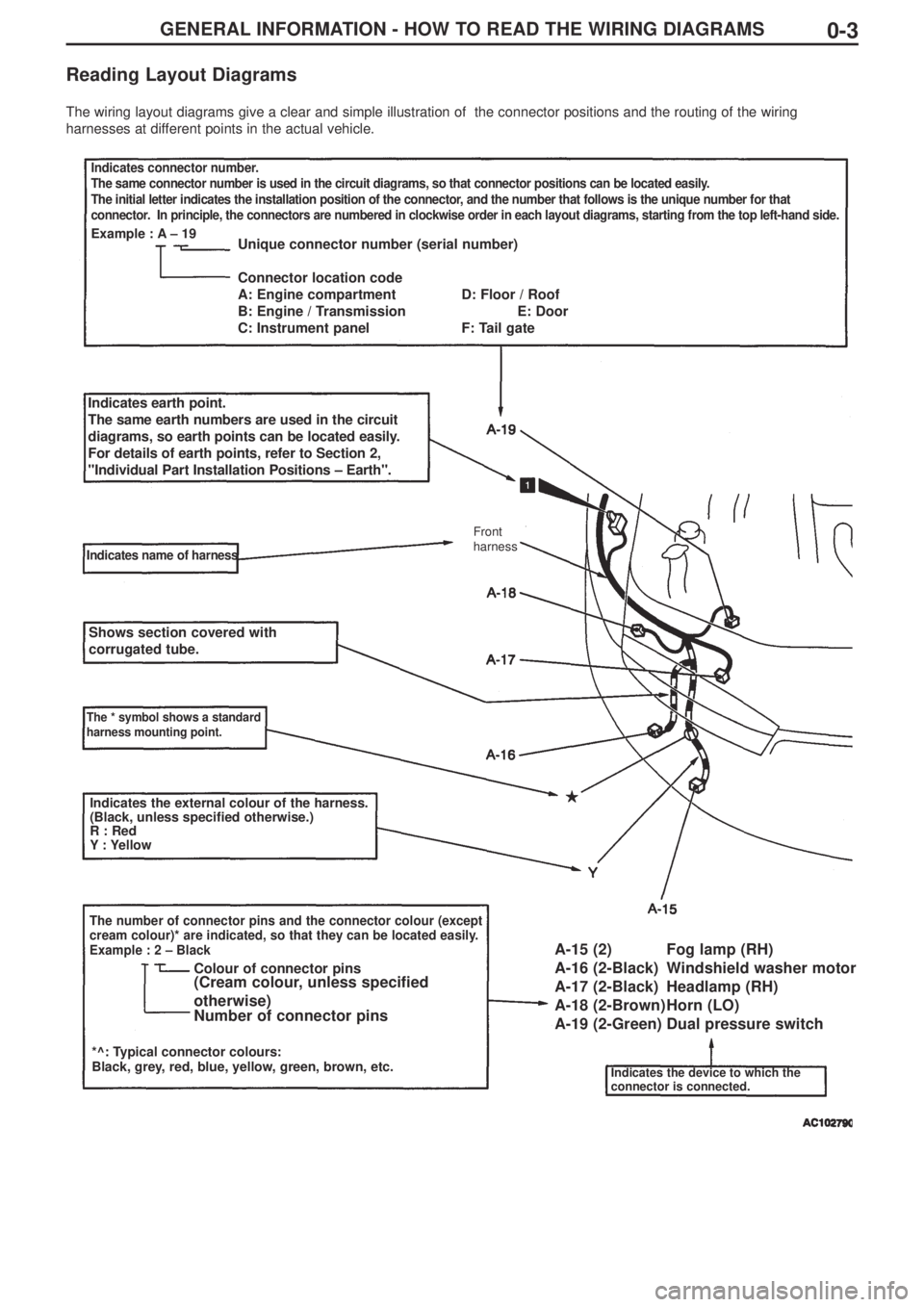
GENERAL INFORMATION - HOW TO READ THE WIRING DIAGRAMS0-3
Reading Layout Diagrams
The wiring layout diagrams give a clear and simple illustration of the connector positions and the routing of the wiring
harnesses at different points in the actual vehicle.
Indicates connector number.
The same connector number is used in the circuit diagrams, so that connector positions can be located easily.
The initial letter indicates the installation position of the connector, and the number that follows is the unique number for that
connector. In principle, the connectors are numbered in clockwise order in each layout diagrams, starting from the top left-hand side.
Example : A – 19Unique connector number (serial number)
Connector location code
A: Engine compartment D: Floor / Roof
B: Engine / Transmission E: Door
C: Instrument panel F: Tail gate
Indicates earth point.
The same earth numbers are used in the circuit
diagrams, so earth points can be located easily.
For details of earth points, refer to Section 2,
"Individual Part Installation Positions – Earth".
Indicates name of harness
Shows section covered with
corrugated tube.
The * symbol shows a standard
harness mounting point.
Indicates the external colour of the harness.
(Black, unless specified otherwise.)
R : Red
Y: Yellow
The number of connector pins and the connector colour (except
cream colour)* are indicated, so that they can be located easily.
Example : 2 – Black
*^: Typical connector colours:
Black, grey, red, blue, yellow, green, brown, etc.
Colour of connector pins(Cream colour, unless specified
otherwise)
Number of connector pinsA-15 (2) Fog lamp (RH)
A-16 (2-Black) Windshield washer motor
A-17 (2-Black) Headlamp (RH)
A-18 (2-Brown) Horn (LO)
A-19 (2-Green) Dual pressure switch
Indicates the device to which the
connector is connected.
Front
harness
Page 142 of 364
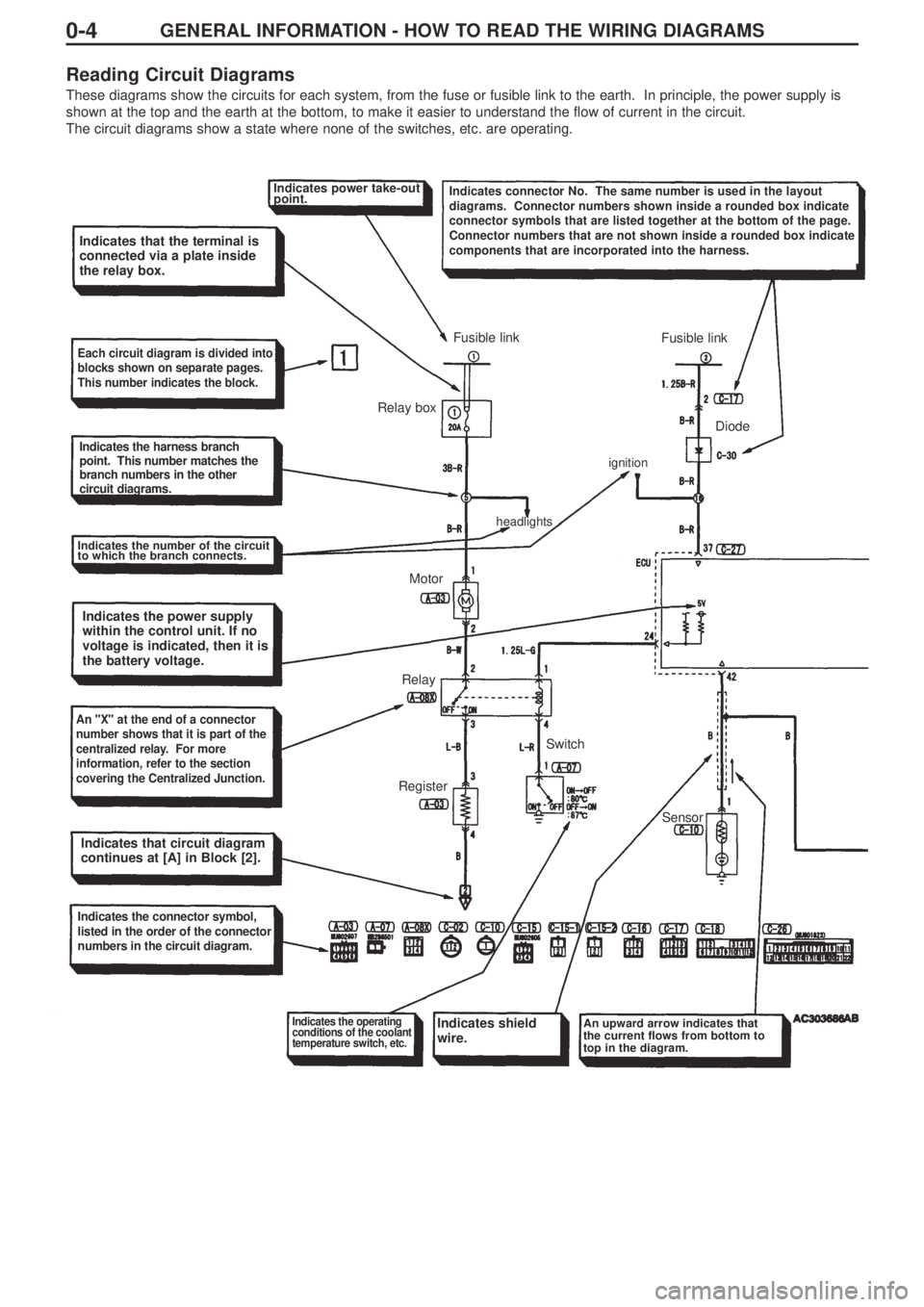
GENERAL INFORMATION - HOW TO READ THE WIRING DIAGRAMS0-4
Reading Circuit Diagrams
These diagrams show the circuits for each system, from the fuse or fusible link to the earth. In principle, the power supply is
shown at the top and the earth at the bottom, to make it easier to understand the flow of current in the circuit.
The circuit diagrams show a state where none of the switches, etc. are operating.
Indicates power take-out
point.Indicates connector No. The same number is used in the layout
diagrams. Connector numbers shown inside a rounded box indicate
connector symbols that are listed together at the bottom of the page.
Connector numbers that are not shown inside a rounded box indicate
components that are incorporated into the harness.
Indicates that the terminal is
connected via a plate inside
the relay box.
Each circuit diagram is divided into
blocks shown on separate pages.
This number indicates the block.
Indicates the harness branch
point. This number matches the
branch numbers in the other
circuit diagrams.
Indicates the number of the circuit
to which the branch connects.
Indicates the power supply
within the control unit. If no
voltage is indicated, then it is
the battery voltage.
An "X" at the end of a connector
number shows that it is part of the
centralized relay. For more
information, refer to the section
covering the Centralized Junction.
Indicates that circuit diagram
continues at [A] in Block [2].
Indicates the connector symbol,
listed in the order of the connector
numbers in the circuit diagram.
Indicates the operating
conditions of the coolant
temperature switch, etc.Indicates shield
wire.An upward arrow indicates that
the current flows from bottom to
top in the diagram.
RegisterRelayMotor Relay boxFusible link
Fusible link
Diode
Sensor Switch
headlightsignition
Page 143 of 364
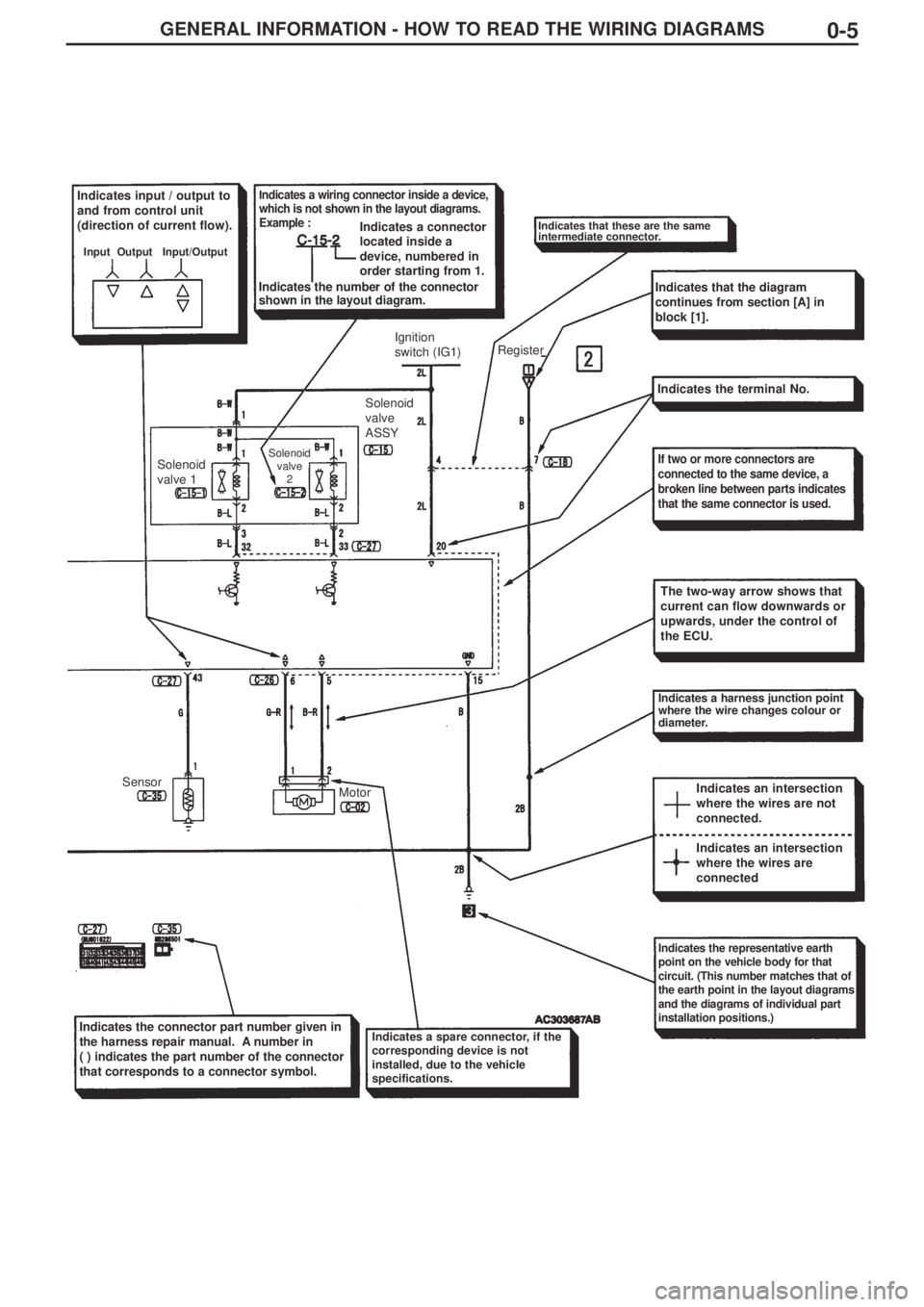
GENERAL INFORMATION - HOW TO READ THE WIRING DIAGRAMS0-5
Indicates input / output to
and from control unit
(direction of current flow).
Input Output Input/Output
Indicates a wiring connector inside a device,
which is not shown in the layout diagrams.
Example :
Indicates a connector
located inside a
device, numbered in
order starting from 1.
Indicates the number of the connector
shown in the layout diagram.
Indicates that these are the same
intermediate connector.
Indicates that the diagram
continues from section [A] in
block [1].
Indicates the terminal No.
If two or more connectors are
connected to the same device, a
broken line between parts indicates
that the same connector is used.
The two-way arrow shows that
current can flow downwards or
upwards, under the control of
the ECU.
Indicates a harness junction point
where the wire changes colour or
diameter.
Indicates an intersection
where the wires are not
connected.
Indicates an intersection
where the wires are
connected
Indicates the representative earth
point on the vehicle body for that
circuit. (This number matches that of
the earth point in the layout diagrams
and the diagrams of individual part
installation positions.)
Indicates a spare connector, if the
corresponding device is not
installed, due to the vehicle
specifications.Indicates the connector part number given in
the harness repair manual. A number in
( ) indicates the part number of the connector
that corresponds to a connector symbol.
Ignition
switch (IG1)
Solenoid
valve 1
Solenoid
valve
2
Solenoid
valve
ASSY
Sensor
MotorRegister
Page 144 of 364
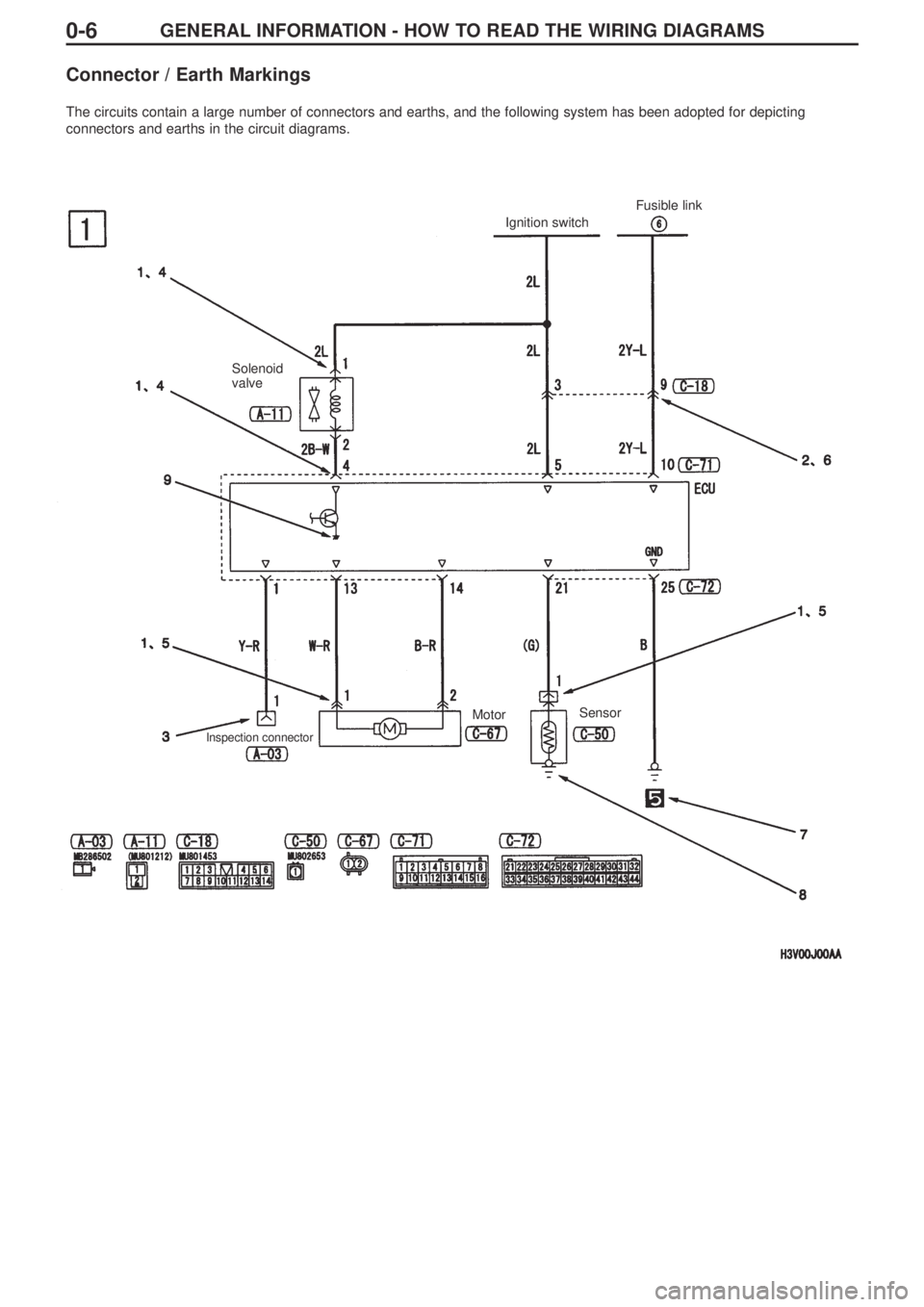
GENERAL INFORMATION - HOW TO READ THE WIRING DIAGRAMS 0-6
Connector / Earth Markings
The circuits contain a large number of connectors and earths, and the following system has been adopted for depicting
connectors and earths in the circuit diagrams.
Ignition switchFusible link
Solenoid
valve
Inspection connector
MotorSensor
Page 145 of 364
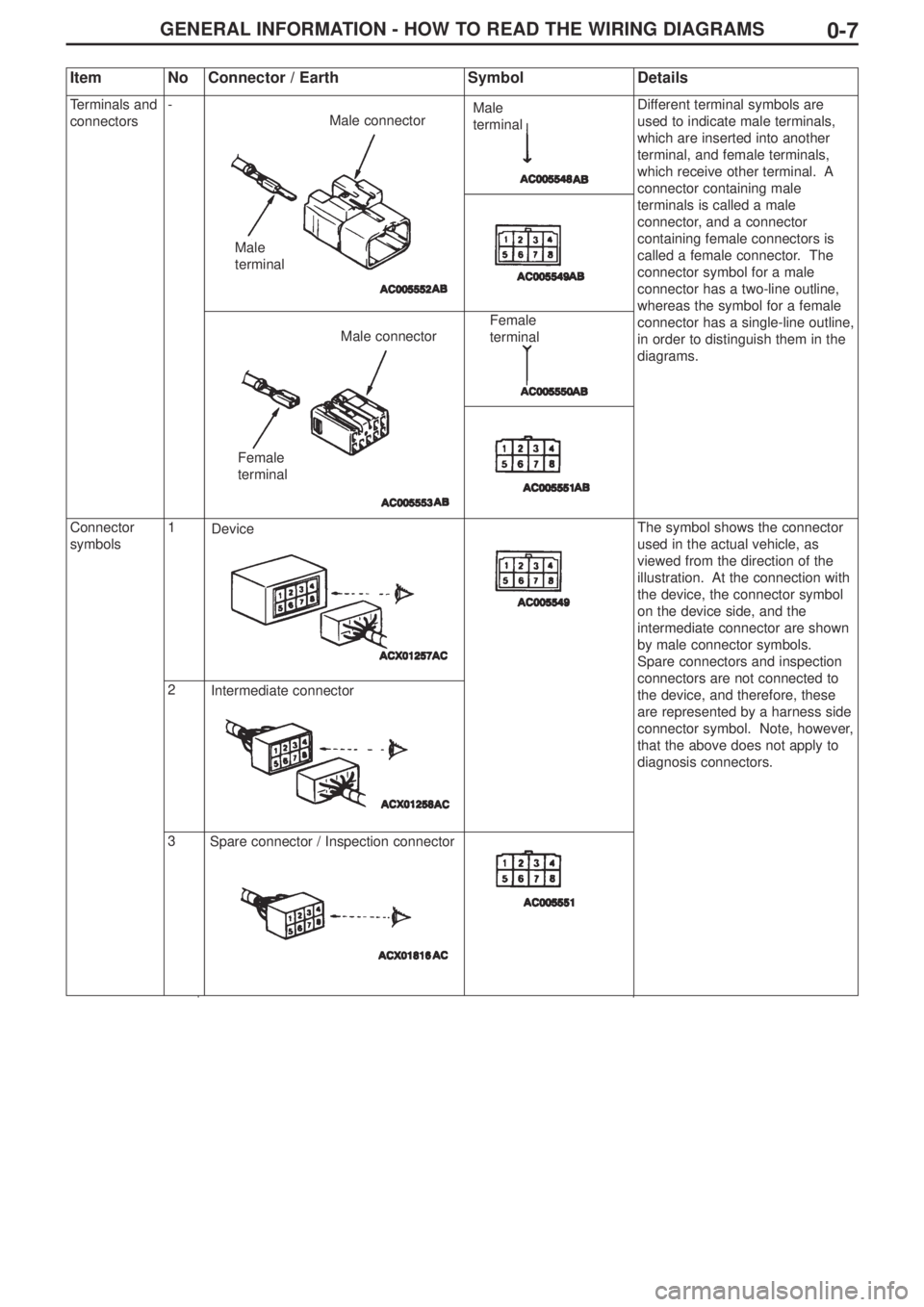
GENERAL INFORMATION - HOW TO READ THE WIRING DIAGRAMS0-7
ItemNoConnector / EarthSymbolDetails
Terminals and
connectors-Different terminal symbols are
used to indicate male terminals,
which are inserted into another
terminal, and female terminals,
which receive other terminal. A
connector containing male
terminals is called a male
connector, and a connector
containing female connectors is
called a female connector. The
connector symbol for a male
connector has a two-line outline,
whereas the symbol for a female
connector has a single-line outline,
in order to distinguish them in the
diagrams.
Connector
symbols1The symbol shows the connector
used in the actual vehicle, as
viewed from the direction of the
illustration. At the connection with
the device, the connector symbol
on the device side, and the
intermediate connector are shown
by male connector symbols.
Spare connectors and inspection
connectors are not connected to
the device, and therefore, these
are represented by a harness side
connector symbol. Note, however,
that the above does not apply to
diagnosis connectors.
2
3
Male connector
Male connector Male
terminal
Female
terminal
Device
Intermediate connector
Spare connector / Inspection connectorMale
terminal
Female
terminal
Page 146 of 364
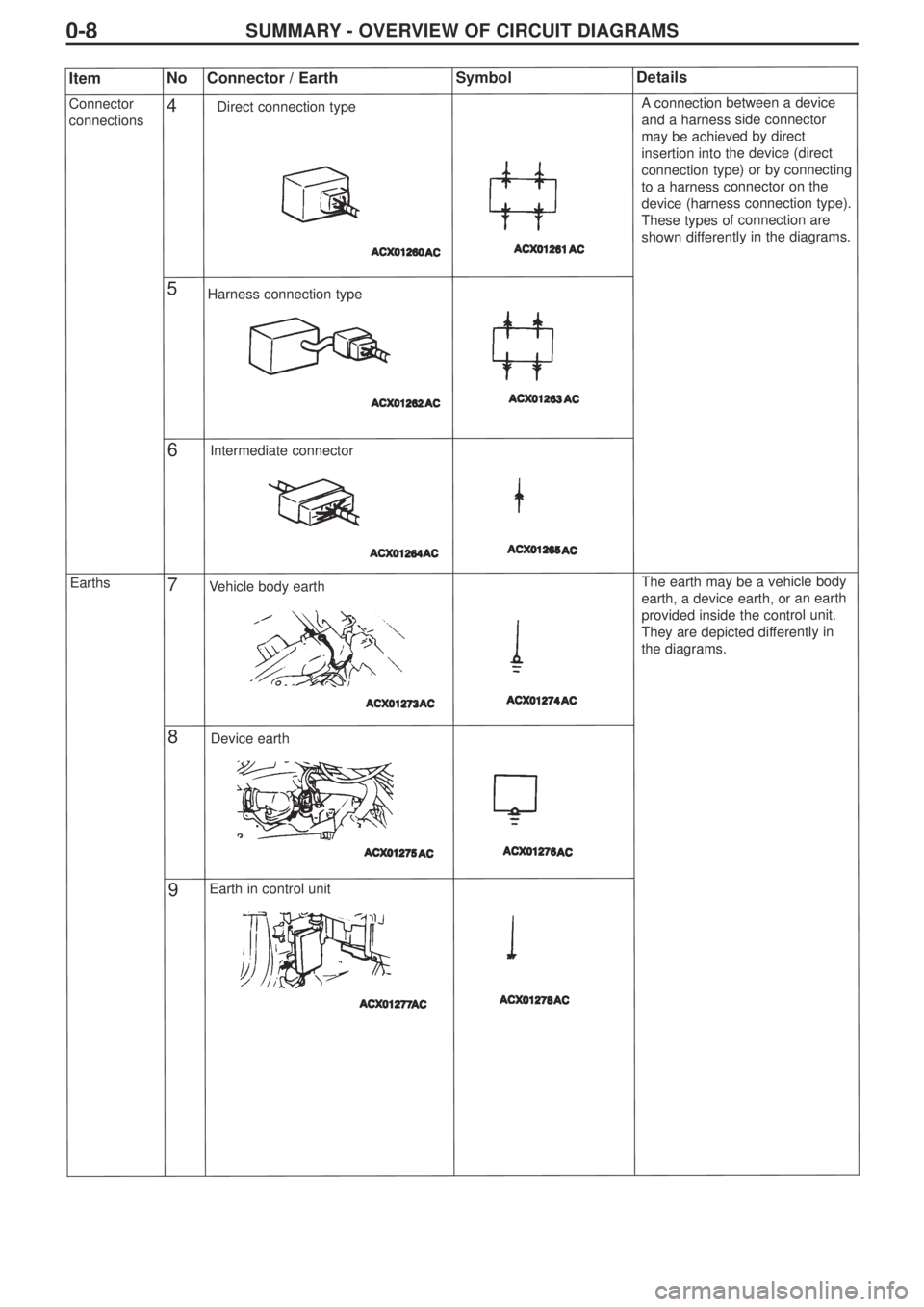
SUMMARY - OVERVIEW OF CIRCUIT DIAGRAMS0-8
ItemNoConnector / EarthSymbolDetails
Connector
connections4Aconnection between a device
and a harness side connector
may be achieved by direct
insertion into the device (direct
connection type) or by connecting
to a harness connector on the
device (harness connection type).
These types of connection are
shown differently in the diagrams.
5
6
Earths7The earth may be a vehicle body
earth, a device earth, or an earth
provided inside the control unit.
They are depicted differently in
the diagrams.
8
9
Harness connection type
Intermediate connector
Vehicle body earth
Device earth
Earth in control unitDirect connection type
Page 147 of 364
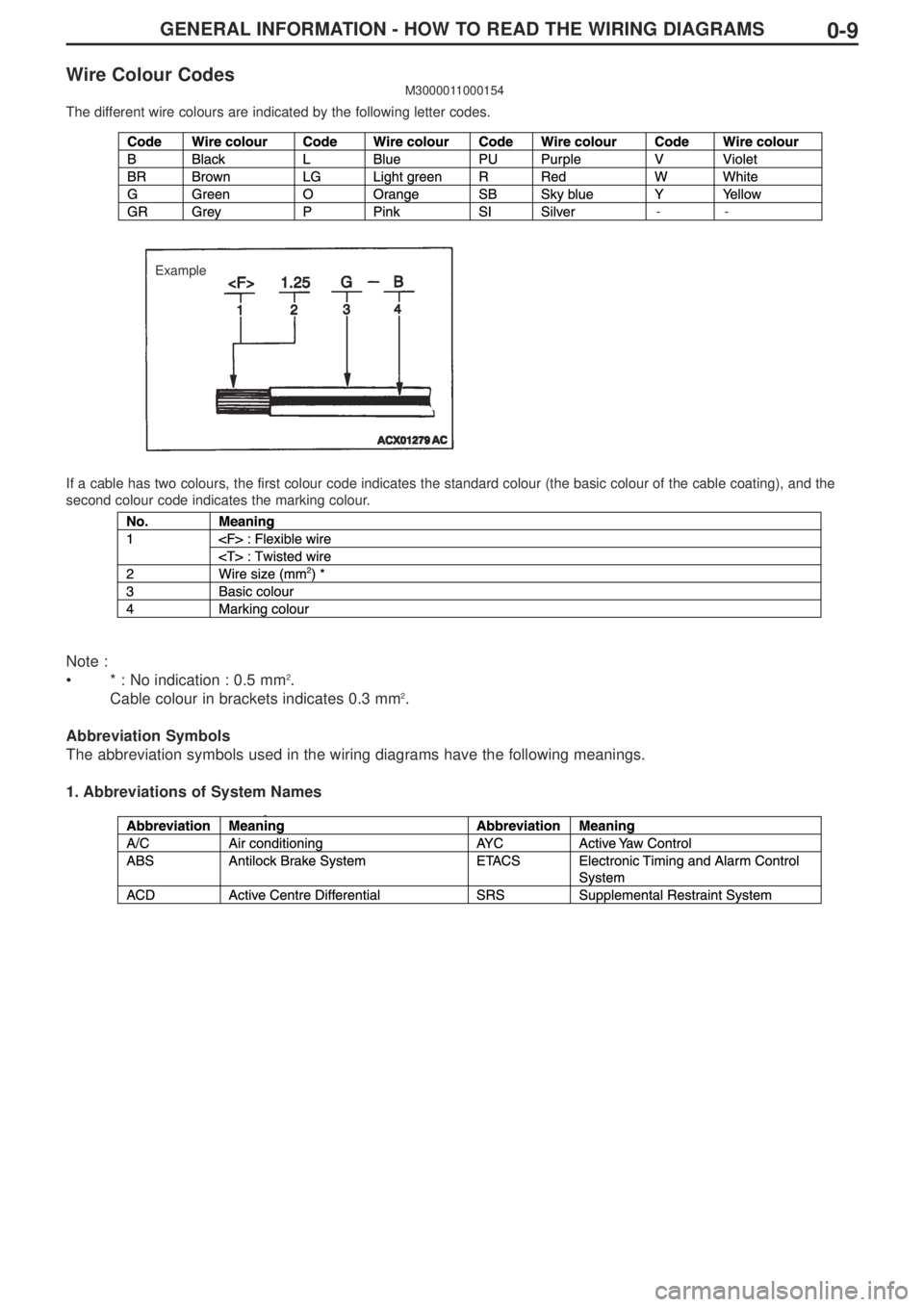
GENERAL INFORMATION - HOW TO READ THE WIRING DIAGRAMS0-9
If a cable has two colours, the first colour code indicates the standard colour (the basic colour of the cable coating), and the
second colour code indicates the marking colour.
Note :
• * : No indication : 0.5 mm2.
Cable colour in brackets indicates 0.3 mm2.
Abbreviation Symbols
The abbreviation symbols used in the wiring diagrams have the following meanings.
1. Abbreviations of System Names
Wire Colour Codes
The different wire colours are indicated by the following letter codes.
Example
M3000011000154
--
Page 148 of 364
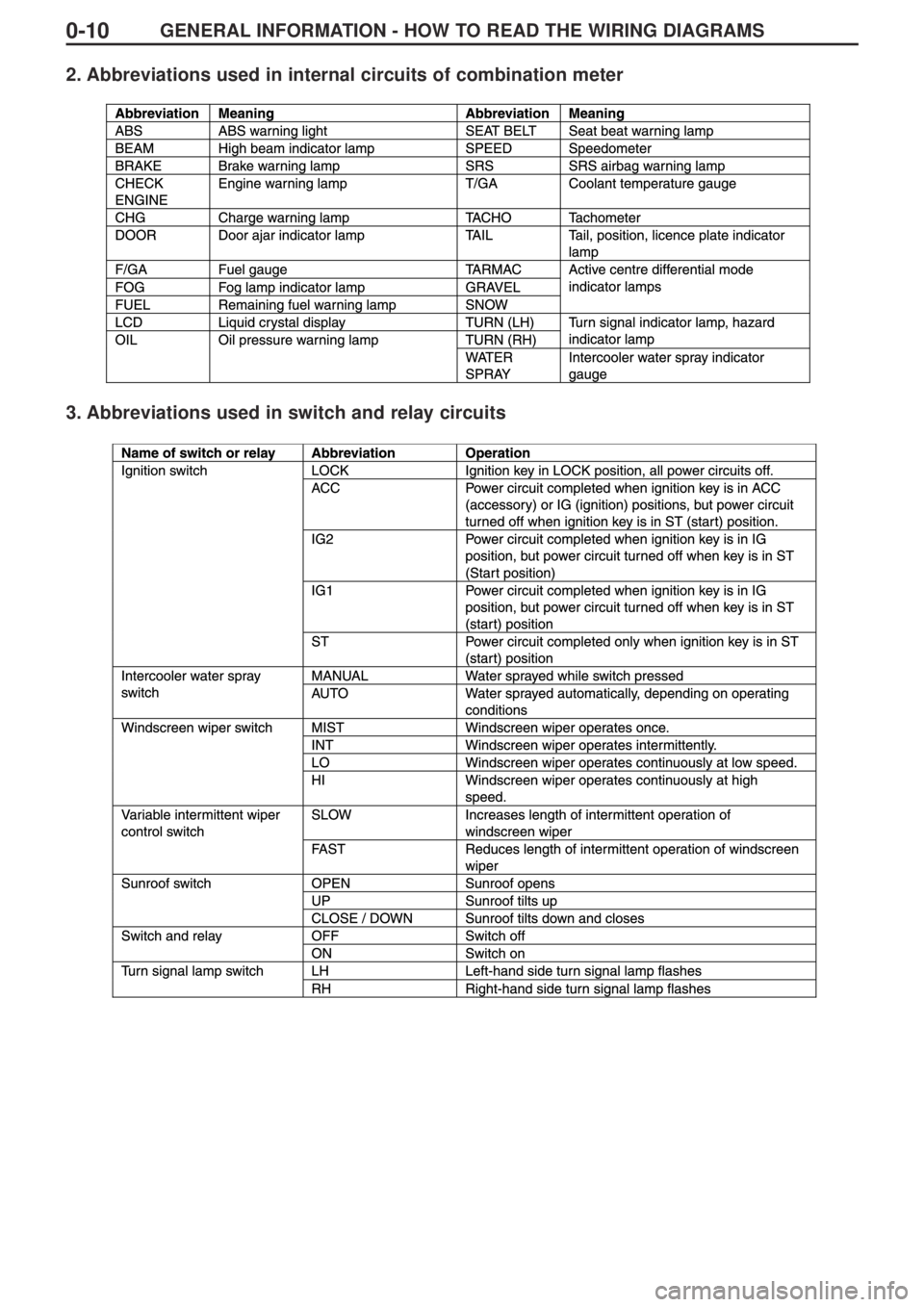
GENERAL INFORMATION - HOW TO READ THE WIRING DIAGRAMS0-10
2. Abbreviations used in internal circuits of combination meter
3. Abbreviations used in switch and relay circuits
Page 149 of 364
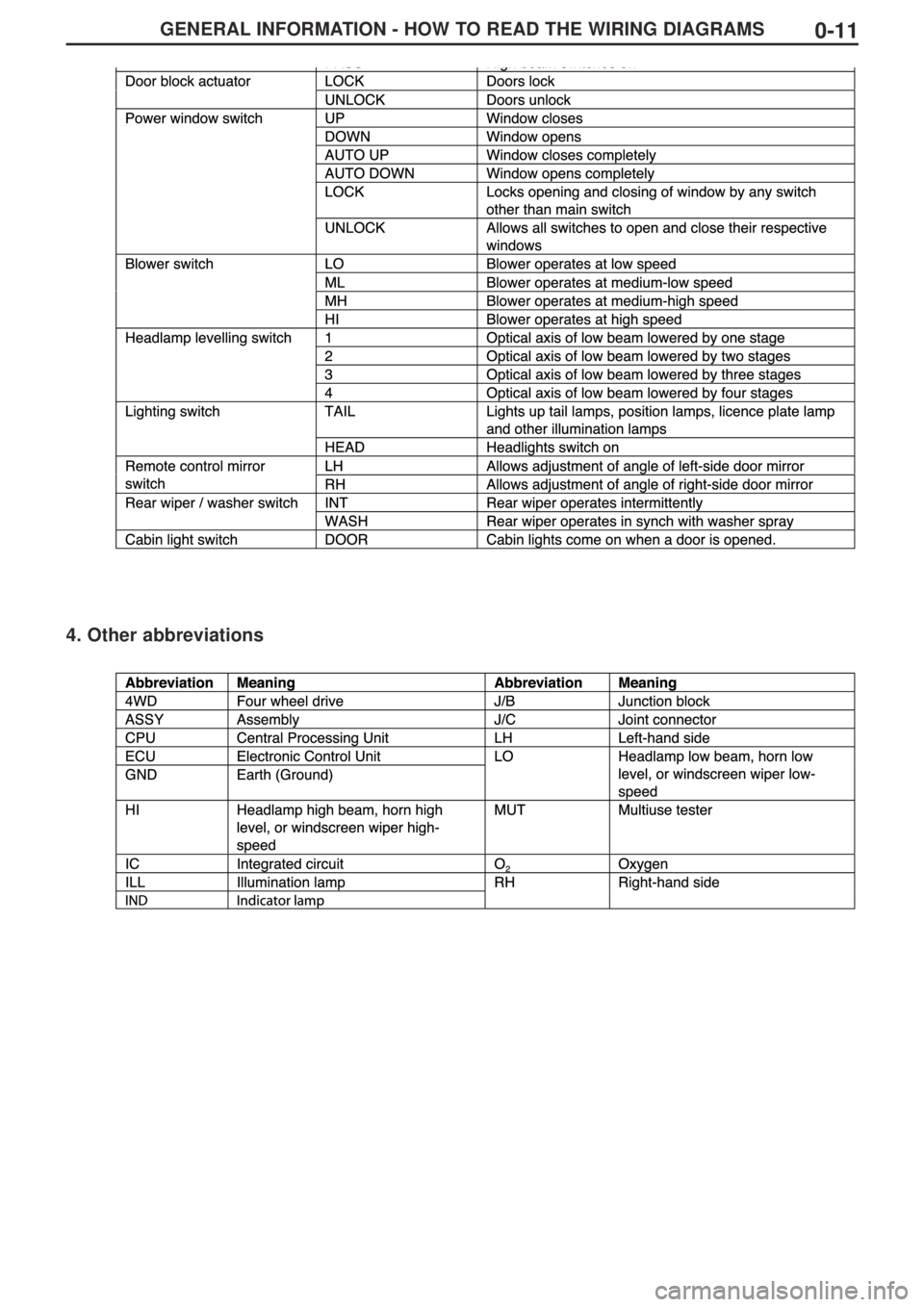
GENERAL INFORMATION - HOW TO READ THE WIRING DIAGRAMS0-11
4. Other abbreviations
Page 150 of 364
